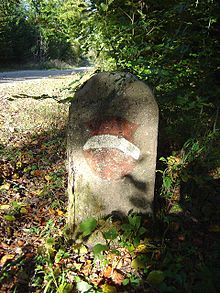Rappert houses
Rappertshäuser ( cf. Rappertshüsern, Rappershausen, Abbizüs ) is a settlement in the municipality of Möhlin in the canton of Aargau in Switzerland that was abandoned in the 17th century .
location
The former municipality of Rappertshäuser is located northeast of Riburg in the Unterforst am Rhein area . The parish ban was on a dump opposite Schwörstadt at 290 m above sea level. M. and covered 193 ha . In the east it bordered Wallbach , in the south and west on Möhlin. In the vicinity of the former settlement there are two Roman control rooms and the "Haumättli" nature reserve on the Rhine. The Breitsee flat moor lies around 1.2 km southwest of the desert .
history
Rappertshüsern was first mentioned in a document in 1376 . The village was mainly fishing , shipping and farming . The fees and interest for the management were the German Order of men to Beuggen paid as well as the rule and castle to Rheinfelden.
As can be seen from a tax book between 1400 and 1455, some citizens of Rappert houses owned considerable property. In the first half of the 15th century the names of the farming families Hartmann, Huber, Jacober, Keller, Meyer, Ruily, Schmit, Steingut, Stragglis, Swob and Winman were recorded. There is evidence that individual citizens of Rappert houses settled in the city of Rheinfelden.
Rappertshäuser was connected to the neighboring towns of Niederriburg (Möhlin) and Wallbach by various routes. The Kilchweg led from the village to the Meli parish church in today's Möhlin. The parish church of Meli was first mentioned in 794 and served eight villages as a place of worship, including Rappert houses.
At the beginning of the 16th century, the St. Martin Abbey in Rheinfelden was the owner of the Mittelhof , the Geldsbachhof and the Kobberhöflein of Rappertshäuser. As a result of disputes between the claims of the owners of the imperial fief and the landlord, a description of the mutual rights was made in 1515, whereby the 535 Jucharten community ban of Rappert houses was allocated to two landowners from Rheinfelden.
During the siege of Rheinfelden by the Swedes between 1633 and 1638, Rappertshäuser was badly affected. The village was looted and destroyed. When the village died out is unknown. There are two similar legends that lead the extinction back to the plague (see legends).
The former municipality
After the village became extinct, nature gradually recaptured the field on the Rhine on which the former buildings were located. The destroyed houses and foundation walls together with the remaining household items were overgrown; later the large gap in the forest was reforested. During the construction of a hunting lodge in the area of the former Rapperthaus, household items came to light.
At the end of 1999, hurricane Lothar devastated the area of the Möhliner Unterforst and again several extensive forest clearings were created. The devastated area has since been cleared; the young wood is now in an early phase of afforestation.
Landmarks
The parish ban of Rappertshäuser was marked by numerous boundary stones, some of which are still in place today. Some of them bear the inscription "RAP" and the Austrian coat of arms and are dated 1602. Some boundary stones are in the Melihus local museum in Möhlin; a bronze copy is also exhibited on the second floor of the Möhlin parish hall. The Rappertshäuserstrasse in the Riburg district, which runs along the north side of the railway embankment , also reminds of the disappeared village.
Say
A long time ago, the Black Death ruled the village of Abbizüs * . The plague had raged particularly hard here and brought the population up to two women, whereupon they inherited the entire parish ban.
But since the two women were afraid of being left alone in the deserted village, they set off for the neighboring village of Wallbach. But Wallbach was afraid of the outbreak of the plague and also did not want more unmarried women in the village, so they were turned away. Sadly, the two hiked to Möhlin, where they were warmly welcomed. After the death of the two women, their inheritance, the entire ban on Rappertshäuser, passed to Möhlin.
According to another version, the two women from Rappertshausen first emigrated to Möhlin, but were turned away there and finally found refuge in Rheinfelden.
(* The name Abbizüs is the mutilated expression of the name Rappertshäuser)
literature
- Karl Schib : History of the village Möhlin. 2nd edition, 1985, pp. 19, 40ff, 58, 101ff, 106, 114f, 134ff, 142
- J. Geissmann, A. John, H. Erismann: The extinct village Abbizüs. In: Aargau sagas, anecdotes and historical texts - people, spirits, mythical animals. Lehrmittelverlag des Kantons Aargau, 1991, p. 143f
- J. Geissmann, A. John, H. Erismann: The black death in Rappert houses. In: Aargau sagas, anecdotes and historical texts - people, spirits, mythical animals. Lehrmittelverlag des Kantons Aargau, 1991, p. 144
Coordinates: 47 ° 35 ′ 13 " N , 7 ° 52 ′ 30" E ; CH1903: 632830 / 270 800

